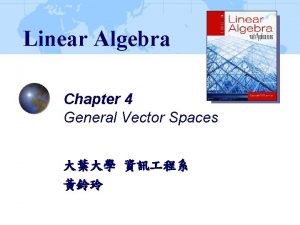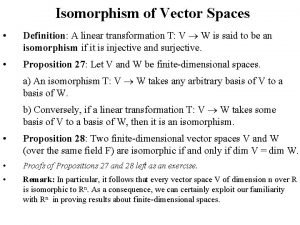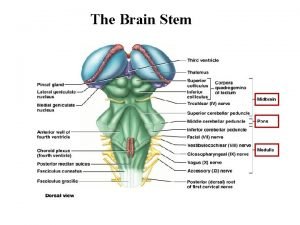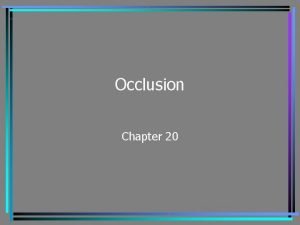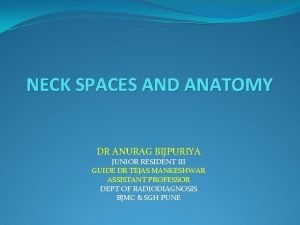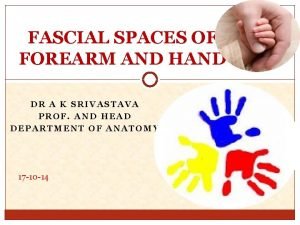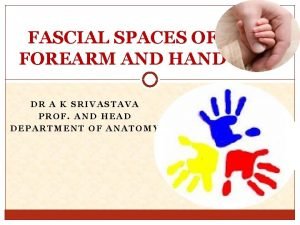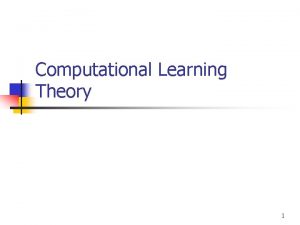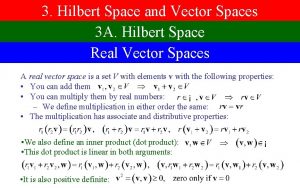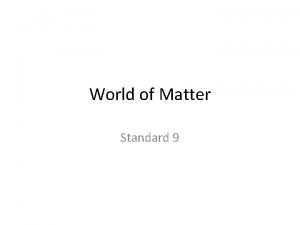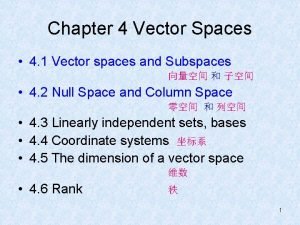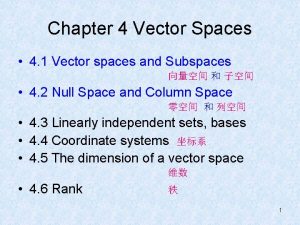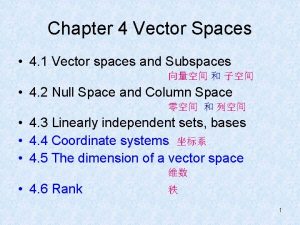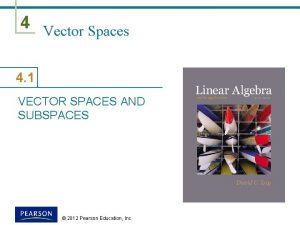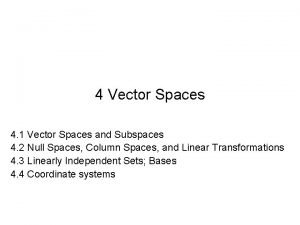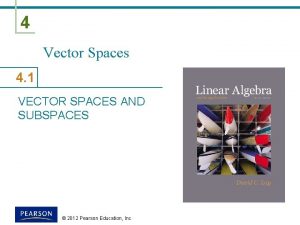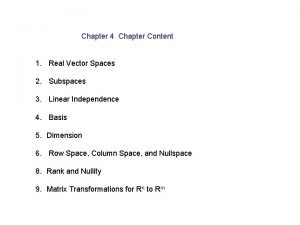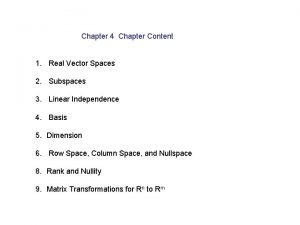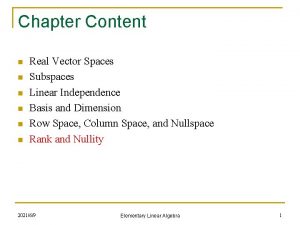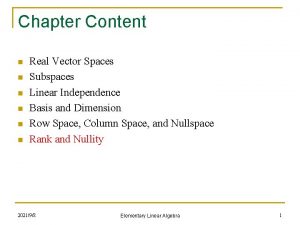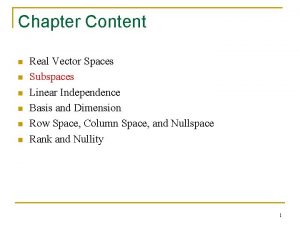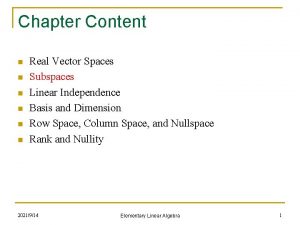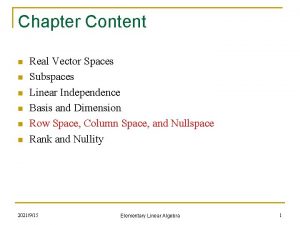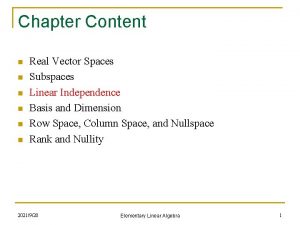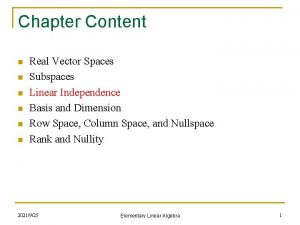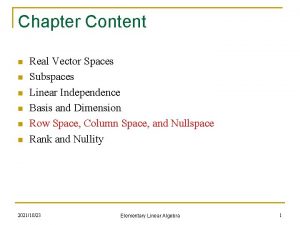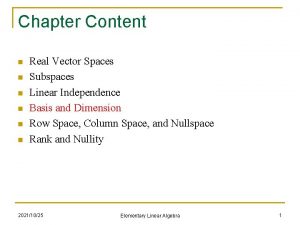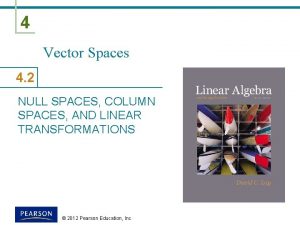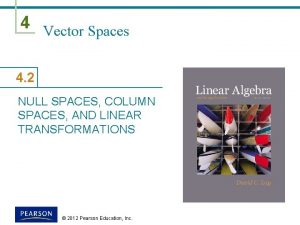Chapter 5 Chapter Content 1 Real Vector Spaces























- Slides: 23

Chapter 5 Chapter Content 1. Real Vector Spaces 2. Subspaces 3. Linear Independence 4. Basis and Dimension 5. Row Space, Column Space, and Nullspace 6. Rank and Nullity

Definition (Vector Space) Let V be an arbitrary nonempty set of objects on which two operations are defined: addition, and multiplication by scalars. If the following axioms are satisfied by all objects u, v, w in V and all scalars k and m, then we call V a vector space and we call the objects in V vectors 1. If u and v are objects in V, then u + v is in V. 2. u + v = v + u 3. u + (v + w) = (u + v) + w 4. There is an object 0 in V, called a zero vector for V, such that 0 + u= u + 0 = u for all u in V. 5. For each u in V, there is an object -u in V, called a negative of u, such that u + (-u) = (-u) + u = 0. 6. If k is any scalar and u is any object in V, then ku is in V. 7. k (u + v) = ku + kv 8. (k + m) u = ku + mu 9. k (mu) = (km) (u) 10. 1 u = u

Remarks • Depending on the application, scalars may be real numbers or complex numbers. Vector spaces in which the scalars are complex numbers are called complex vector spaces, and those in which the scalars must be real are called real vector spaces. • The definition of a vector space specifies neither the nature of the vectors nor the operations. Any kind of object can be a vector, and the operations of addition and scalar multiplication may not have any relationship or similarity to the standard vector operations on. • The only requirement is that the ten vector space axioms be satisfied.

Example ( Is a Vector Space) The set V = with the standard operations of addition and scalar multiplication is a vector space. (Axioms 1 and 6 follow from the definitions of the standard operations on ; the remaining axioms follow from Theorem 4. 1. 1. ) The three most important special cases of are R (the real numbers), vectors in the plane), and (the vectors in 3 -space). (the

Example (2× 2 Matrices) Show that the set V of all 2× 2 matrices with real entries is a vector space if vector addition is defined to be matrix addition and vector scalar multiplication is defined to be matrix scalar multiplication. Solution: Let and (1) we must show that u + v is a 2× 2 matrix. (2) Want to show that u + v = v + u (3) Similarly we can show that u + ( v + w ) = ( u + v )+ w. (4) Define 0 to be such that

(5) Define the negative of u to be (6) If k is any scalar and u is a 2 X 2 matrix, then such that is 2 X 2 matrix. (7)-(9) will be obtained by similar approach. (10) Thus, the set V of all 2× 2 matrices with real entries is a vector space.

Example: Given the set of all triples of real numbers ( x, y, z ) with the operations Show that it’s a vector space under the given operation. Solution: We must check all ten properties: (1) If (x, y, z) and (x’, y’, z’) are triples of real numbers, so is (x, y, z) + (x’, y’, z’) = (x + x’, y +y’, z + z’). (2) (x, y, z) + (x’, y’, z’) = (x + x’, y + y’, z + z’)= (x’, y’, z’) + (x, y, z). (3) (x, y, z) + [(x’, y’, z’) + (x’’, y’’, z’’)] = (x, y, z) + [(x’, y’, z’) + (x’’, y’’, z’’)]. (4) There is an object 0, (0, 0, 0), such that (0, 0, 0) + (x, y, z) = (x, y, z) + (0, 0, 0)= (x, y, z). (5) For each positive real x, (-x, -y, -z) acts as the negative: (x, y, z) + (-x, -y, -z) = (-x, -y, -z) + (x, y, z) =(x, y, z)

(6) If k is a real and (x, y, z) is a triple of real numbers, then k (x, y, z) = (kx, y, z) is again a triple of real numbers. (7) k[(x, y, z) + (x’, y’, z’)] = (k(x+x’), y+y’, z+z’) = k(x, y, z) + k(x’, y’, z’) (8) (k + m) (x, y, z) = ((k + m)x, y, z) = k (x, y, z) + m(x, y, z) (9) k(m(x, y, z)) = (kmx, y, z) = (km)(x, y, z) (10) 1 (x, y, z) = (x, y, z) Thus, the set of all triples of real numbers ( x, y, z ) with the operations is a vector space under the given operation.

Example (Not a Vector Space) Let V = R 2 and define addition and scalar multiplication operations as follows: If u = (u 1, u 2) and v = (v 1, v 2), then define u + v = (u 1 + v 1, u 2 + v 2) and if k is any real number, then define k u = (k u 1, 0) There are values of u for which Axiom 10 fails to hold. For example, if u = (u 1, u 2) is such that u 2 ≠ 0, then 1 u = 1 (u 1, u 2) = (1 u 1, 0) = (u 1, 0) ≠ u Thus, V is not a vector space with the stated operations

The Zero Vector Space Let V consist of a single object, which we denote by 0, and define 0 + 0 = 0 and k 0 = 0 for all scalars k. It’s easy to check that all the vector space axioms are satisfied. We called this the zero vector space.

Theorem 5. 1. 1 Let V be a vector space, u be a vector in V, and k a scalar; then: (a) 0 u = 0 (b) k 0 = 0 (c) (-1) u = -u (d) If k u = 0 , then k = 0 or u = 0.

5. 2 Subspaces Definition A subset W of a vector space V is called a subspace of V if W is itself a vector space under the addition and scalar multiplication defined on V. Theorem 5. 2. 1 If W is a set of one or more vectors from a vector space V, then W is a subspace of V if and only if the following conditions hold: a) If u and v are vectors in W, then u + v is in W. b) If k is any scalar and u is any vector in W , then ku is in W. Remark Theorem 5. 2. 1 states that W is a subspace of V if and only if W is a closed under addition (condition (a)) and closed under scalar multiplication (condition (b)).

Example All vectors of the form (a, 0, 0) is a subspace of R 3. • The set is closed under vector addition because (a, 0, 0) + (b, 0, 0) = (a + b, 0, 0) • It is closed under scalar multiplication because k(a, 0, 0) = (ka, 0, 0) Therefore it is a subspace of R 3.

Example (Not a Subspace) Let W be the set of all points (x, y) in R 2 such that x ≥ 0 and y ≥ 0. These are the points in the first quadrant. The set W is not a subspace of R 2 since it is not closed under scalar multiplication. For example, v = (1, 1) lines in W, but its negative (-1)v = -v = (-1, -1) does not.

Subspaces of Mnn The set of n×n diagonal matrices forms subspaces of Mnn, since each of these sets is closed under addition and scalar multiplication. The set of n×n matrices with integer entries is NOT a subspace of the vector space Mnn of n×n matrices. This set is closed under vector addition since the sum of two integers is again an integer. However, it is not closed under scalar multiplication since the product ku where k is real and a is an integer need not be an integer. Thus, the set is not a subspace.

Solution Space of Homogeneous Systems If Ax = b is a system of the linear equations, then each vector x that satisfies this equation is called a solution vector of the system. Theorem 5. 2. 2 If Ax = 0 is a homogeneous linear system of m equations in n unknowns, then the set of solution vectors is a subspace of Rn. Remark: Theorem 5. 2. 2 shows that the solution vectors of a homogeneous linear system form a vector space, which we shall call the solution space of the system.

Linear Combination Definition A vector w is a linear combination of the vectors v 1, v 2, …, vr if it can be expressed in the form w = k 1 v 1 + k 2 v 2 + · · · + kr vr where k 1, k 2, …, kr are scalars. Example: Vectors in R 3 are linear combinations of i, j, and k Every vector v = (a, b, c) in R 3 is expressible as a linear combination of the standard basis vectors i = (1, 0, 0), j = (0, 1, 0), k = (0, 0, 1) Since v= a(1, 0, 0) + b(0, 1, 0) + c(0, 0, 1) = a i + b j + c k

Example Consider the vectors u = (1, 2, -1) and v = (6, 4, 2) in R 3. Show that w = (9, 2, 7) is a linear combination of u and v and that w′ = (4, -1, 8) is not a linear combination of u and v. Solution. In order for w to be a linear combination of u and v, there must be scalars k 1 and k 2 such that w = k 1 u + k 2 v; (9, 2, 7) = (k 1 + 6 k 2, 2 k 1 + 4 k 2, -k 1 + 2 k 2) Equating corresponding components gives k 1 + 6 k 2 = 9 2 k 1+ 4 k 2 = 2 -k 1 + 2 k 2 = 7 Solving this system yields k 1 = -3, k 2 = 2, so w = -3 u + 2 v

Similarly, for w‘ to be a linear combination of u and v, there must be scalars k 1 and k 2 such that w'= k 1 u + k 2 v; (4, -1, 8) = k 1(1, 2, -1) + k 2(6, 4, 2) or (4, -1, 8) = (k 1 + 6 k 2, 2 k 1 + 4 k 2, -k 1 + 2 k 2) Equating corresponding components gives k 1 + 6 k 2 = 4 2 k 1+ 4 k 2 = -1 - k 1 + 2 k 2 = 8 This system of equation is inconsistent, so no such scalars k 1 and k 2 exist. Consequently, w' is not a linear combination of u and v.

Linear Combination and Spanning Theorem 5. 2. 3 If v 1, v 2, …, vr are vectors in a vector space V, then: (a) The set W of all linear combinations of v 1, v 2, …, vr is a subspace of V. (b) W is the smallest subspace of V that contain v 1, v 2, …, vr in the sense that every other subspace of V that contain v 1, v 2, …, vr must contain W. Definition If S = {v 1, v 2, …, vr} is a set of vectors in a vector space V, then the subspace W of V containing of all linear combination of these vectors in S is called the space spanned by v 1, v 2, …, vr, and we say that the vectors v 1, v 2, …, vr span W. To indicate that W is the space spanned by the vectors in the set S = {v 1, v 2, …, vr}, we write W = span (S) or W = span{v 1, v 2, …, vr}.

Example If v 1 and v 2 are non-collinear vectors in R 3 with their initial points at the origin, then span{v 1, v 2}, which consists of all linear combinations k 1 v 1 + k 2 v 2 is the plane determined by v 1 and v 2. Similarly, if v is a nonzero vector in R 2 and R 3, then span {v}, which is the set of all scalar multiples kv, is the line determined by v.

Example Determine whether v 1 = (1, 1, 2), v 2 = (1, 0, 1), and v 3 = (2, 1, 3) span the vector space R 3. Solution Is it possible that an arbitrary vector b = (b 1, b 2, b 3) in R 3 can be expressed as a linear combination b = k 1 v 1 + k 2 v 2 + k 3 v 3 ? b = (b 1, b 2, b 3) = k 1(1, 1, 3) + k 2(1, 0, 1) + k 3(2, 1, 3) = (k 1+k 2+2 k 3, k 1+k 3, 2 k 1+k 2+3 k 3) Or k 1 + k 2 + 2 k 3 = b 1 k 1 + k 3 = b 2 2 k 1 + k 2 + 3 k 3 = b 3 This system is consistent for all values of b 1, b 2, and b 3 if and only if the coefficient matrix has a nonzero determinant. However, det(A) = 0, so that v 1, v 2, and v 3, do not span R 3.

Theorem 5. 2. 4 If S = {v 1, v 2, …, vr} and S′ = {w 1, w 2, …, wr} are two sets of vector in a vector space V, then span{v 1, v 2, …, vr} = span{w 1, w 2, …, wr} if and only if each vector in S is a linear combination of these in S′ and each vector in S′ is a linear combination of these in S.
 Basis of a vector space
Basis of a vector space Real content and carrier content in esp
Real content and carrier content in esp Isomorphism of vector spaces
Isomorphism of vector spaces Static content vs dynamic content
Static content vs dynamic content Find a unit vector in the direction of the given vector.
Find a unit vector in the direction of the given vector. Coordenadas cartesianas
Coordenadas cartesianas Vector resolution examples
Vector resolution examples What is fixed vector
What is fixed vector Etwinning twinspace net
Etwinning twinspace net Hardened magma squeezed into vertical spaces between rocks
Hardened magma squeezed into vertical spaces between rocks Midbrain
Midbrain Ollies raleigh
Ollies raleigh Torsoverted tooth
Torsoverted tooth Danger space neck
Danger space neck Fascial spaces of the hand
Fascial spaces of the hand Boundaries of midpalmar space
Boundaries of midpalmar space Predentate space
Predentate space Designing spaces for effective learning
Designing spaces for effective learning Sample complexity for finite hypothesis spaces
Sample complexity for finite hypothesis spaces Primary epithelial band
Primary epithelial band Danger space of neck
Danger space of neck Hilbert space
Hilbert space Spaces between particles of liquid
Spaces between particles of liquid Types of performance space
Types of performance space
